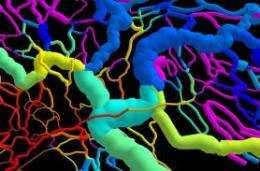New Approach Developed to Improve Drug Delivery in Tumors

(PhysOrg.com) -- By using mathematical modeling to understand blood flow, researchers -- including the UA's Timothy Secomb, a pioneer in the field -- have proposed a novel approach to treating cancerous tumors.
Researchers know that blood vessels are poor at transporting oxygen and cancer-fighting drugs in tumors. Using mathematical modeling, scientists have found a new approach that may improve drug delivery in the tumor and increase its effectiveness.
Timothy Secomb of the University of Arizona and his colleagues discovered that impaired communication in tumor microvascular networks can lead to the shunting of blood away from some regions of the tumor.
Treatments that inhibit the growth of new vessels, they argue, may help restore communication and improve flow and distribution in tumor blood vessels.
"We know the blood supply in the tumors is abnormal, and we've asked, ‘What's different about it?'" Secomb said. "By improving circulation - getting the vasculature working again - there is a better chance of getting chemotherapy drugs to the tumor."
Secomb collaborated on this work with Axel Pries of Charité in Berlin, Germany, and Mark Dewhirst of Duke University Medical Center. The results were published in the latest online edition of Nature Reviews Cancer.
Secomb is a pioneer in applying mathematical approaches to understanding how blood flows in the smallest branches of the circulatory system. He is a professor in the UA departments of physiology and mathematics and is a member of Arizona Research Laboratories, BIO5 and the Arizona Cancer Center.
In detail, the researchers examined communication along blood vessel walls, which is needed to coordinate the distribution of blood flow. Gap junctions connect the endothelial cells of the vessels. The researchers theorize that the gap junctions do not exist or don't work well in tumors, which lead to loss of communication. The vessel structure in the tumor reflects this breakdown of communication.
Long pathways and shortcuts exist from arteries to the veins. The researchers predicted that, in tumors, the shortcuts tend to grow in diameter, shunting the flow away from the long pathways.
One line of attack is to give a VEGF (vascular endothelial growth factor) antagonist to improve communication and reduce shunting, which enables better delivery of anti-tumor therapies.
The researchers say that approaches targeted at improving gap junction communication may be able to take advantage of this concept in a more predictable manner.
More information: www.nature.com/nrc/index.html















